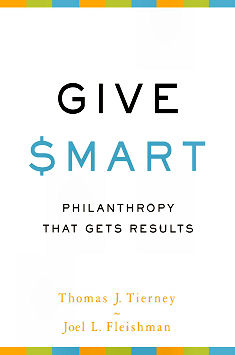
|
Posted May 5, 2011
Here is a book for anyone who deals with asking for money. It is posted to enable you to enter into the mind and challenges philanthropists/parishioners/grantees face when considering to give you money. Book: Give $Mart: Philanthropy That Gets Results Authors: Thomas J. Tierney and Joel L. Fleishman Public Affairs. New York. 2011. Pp. 245 An Excerpt from the Jacket:
Almost a decade ago, Thomas J Tierney left Bain & Company to co-found The Bridgespan Group, a nonprofit focused on helping donors and nonprofit leaders to develop and execute strategies to accelerate social change. In Give Smart, Tierney pools his hands-on knowledge with philanthropy expert Joel L. Fleishman to create a much-needed primer for philanthropists and the nonprofit organizations they support — including those of the Bill and Melinda Gates Foundation and the John D. And Catherine T. MacArthur Foundation — Give Smart picts up where Jim Collins’ Good to Great and the Social Sectors left off and presents the definitive guide for engaged donors and nonprofit leaders. An Excerpt from the Book: Broadly stated, a win in philanthropy is a win for society, a change for the better that probably wouldn’t have occurred without a concerted effort to bring it about. Maybe that’s a polluted river brought back to life, or lower maternal mortality rates in a developing country, or a sharp increase in the number of a city’s chronically homeless men and women placed in permanent housing. Getting clear about what will constitute success for a given grant or initiative involves translating the win you envision for society into some real-world result or outcome that can inform decisions about how and where to allocate precious resources more effectively. The broader the win you envision, the more important it will be to develop some real specificity about what it is you intend to accomplish with your piece of the puzzle. For example, suppose that climate change is the issue you feel passionate about. You (like us) may have heard philanthropists wax eloquent about their determination to “reverse global warming.” Such a vision can be inspirational and highly motivating. But besides being too big for any single nation-state — let alone any individual donor or foundation — to achieve, it is also too broad to help you make tradeoffs. As a result, it cannot provide a useful lens for making decisions about how to allocate scarce philanthropic resources most effectively. To develop that kind of strategic clarity, you need to translate your vision of a world in which global climate change has been reversed into specific high-level outcomes that can drive resource-allocation decisions and tradeoffs. What might qualify? The passage of federal cap-and-trade legislation in the United States. Ten thousand acres of Brazilian rain forest saved from logging. A reduction in carbon emissions from coal-fired power plants in China. Table of Contents: 1. What are my values and belief? 2. What is “success,” and how can it be achieved? 3. What am I accountable for? 4. What will it take to get the job done? 5. How do I work with grantees? 6. Am I getting better? A Monday morning checklist With gratitude Special acknowledgment: Nan Stone |
|
